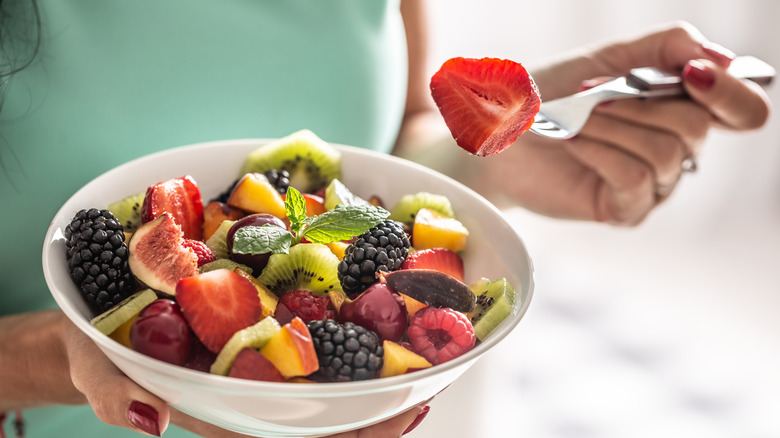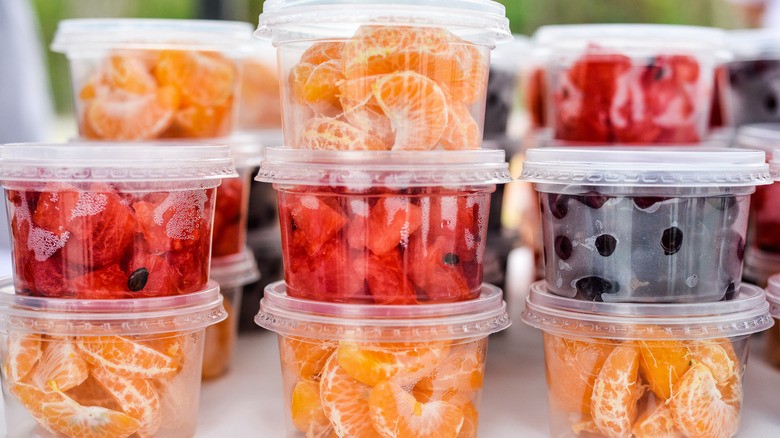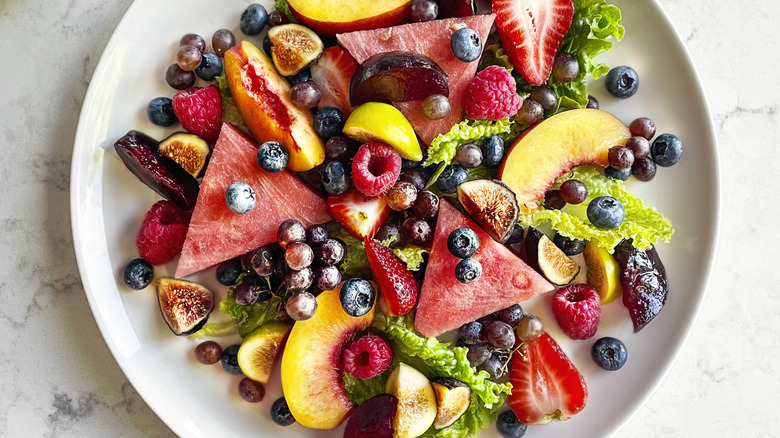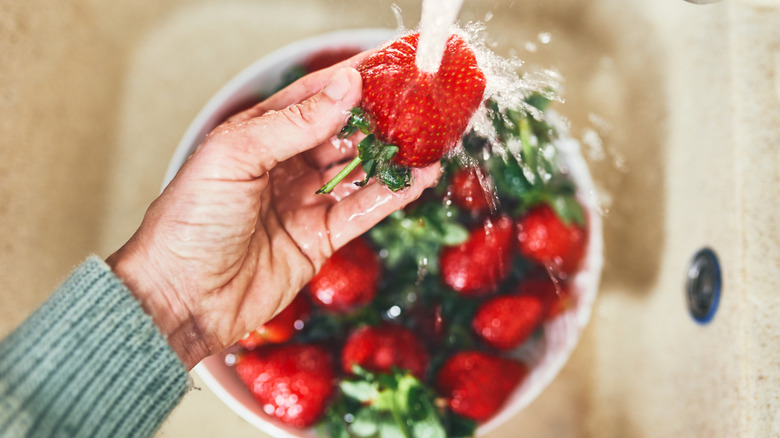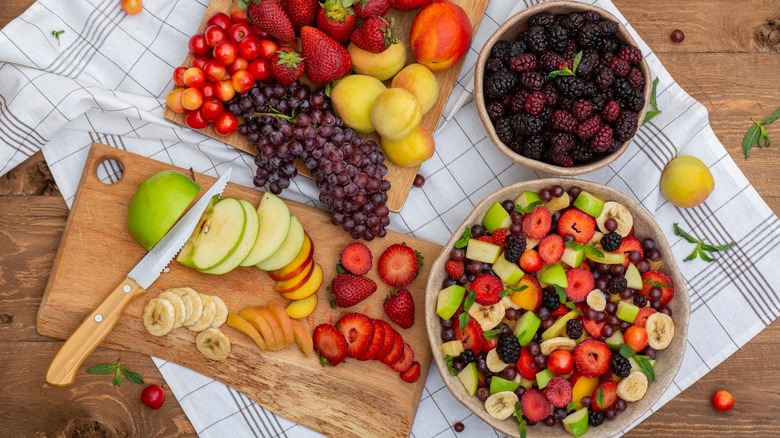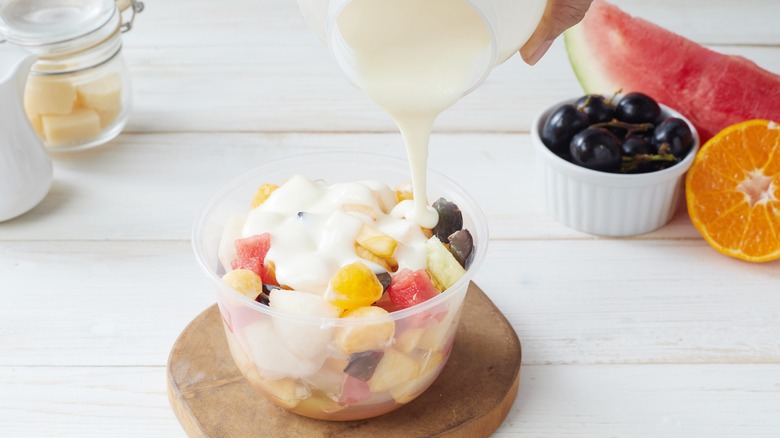5 Mistakes To Avoid When Making Fruit Salad
Fruit salad is a quintessential summer side dish and arguably one of the most underrated things to bring to a barbecue. But odds are, you've witnessed a fruit salad go untouched by guests and be left to slowly perish in the hot sun during at least one summer get-together. That's because not all fruit salads are made equal, and as great as they can be, fruit salad can also be fragile and a bit temperamental.
It seems like a dish that would be straightforward—chop up some fruit, put it in a bowl, and toss with a little lemon juice — that's all there is to it, right? Sadly, it's not that simple, and there are many fruit salad pitfalls that even the most experienced chefs can run into. From mushy, browned fruit to clashing flavors to a concoction that resembles fruit soup more than a salad, don't fall victim to common fruit salad mistakes. We'll walk you through everything that could go wrong and how to avoid it so that you can spend your next summer potluck fielding questions about how good your fruit salad was rather than go home with the same full bowl you arrived with.
Making the fruit salad too far in advance
For all its amazing qualities, longevity is not one that fruit salad possesses. Especially if it's being enjoyed outside at a barbecue or summer potluck. Heat, time, and oxidization are all enemies of a fresh and delicate fruit salad. While you certainly can prep in advance, fruit salads are best made the same day they're going to be eaten. Some fruits brown very quickly, while others start to break down and get mushy when left out or sitting in juices. The enzymes found in fruits are triggered by oxidization when exposed to air, kicking off a chemical reaction that results in the fruit tissue browning or getting too soft.
The absolute best ways to keep your fruit salad fresh is by adding protective ingredients like citrus, sugar, or cream. All of these ingredients will create a seal around the fruit that keeps it from being overexposed to air, thus preventing the browning. Honey even has natural preservative properties that make it that much more effective at keeping fruit salad fresh. If you need to prep your salad in advance, try to coat the fruits with a little bit of citrus like lemon or lime juice and a dash of sweetness from either sugar or honey. Then, immediately store in an airtight container in the fridge. Keeping the mixture cold and protected from air is key in making sure your salad lasts long enough to make it to the barbecue. When stored properly, fruit salad can be stored in the fridge for three to four days.
Using too many kinds of fruit or making a mix that isn't cohesive
Fruit salad should be a beautiful harmony between a curated mix of fruits, not a hodgepodge of clashing textures and flavors. When choosing what kinds of fruits to use, it's best to go by what's in season in your area. The fresher the fruit, the better, and those that are in season together tend to be complementary in flavor, too. Don't go overboard and throw every ripe fruit you can find into your fruit salad. Rather, take a moment to really think about what would go together nicely based on taste and texture. For example, a fruit salad that only features soft fruits might be a little underwhelming. But throw in an apple, watermelon cubes, or a little bit of sliced jicama, and you've got a variety in texture that's worth going back for another helping of.
It's important to use fruits with a variety of flavor profiles too. Some fruits tend to be on the sweeter side, while others will have a tart flavor; try to strike a balance between the two. Mango and pineapple both tend to be on the sweet end of the spectrum, so if you're going for a tropical fruit salad, incorporate some tart blueberries, kiwifruit, green apples, or starfruit into the mix. It may be tempting to throw your entire fruit bounty into the bowl, but limiting your salad to just a handful of complementary fruits that don't drown one another out is key in making a fruit salad that diners will remember. Sometimes, simple really is best.
Not properly washing or soaking your fruits
As much as we would love to pretend otherwise, fruit is pretty dirty, and washing it before eating is an absolute non-negotiable. No one wants to pick dirt and grit out of their teeth when they're just trying to enjoy a fruit salad. And it's not just dirt we're looking to get rid of but the germs and microbes that are invisible to the naked eye too. The FDA estimates that approximately 48 million people get sick from contaminated food every single year. Don't let your barbecue guest list become a part of that club.
Make sure you give all of your chosen fruits a proper cleaning before chopping them up. Some fruits can be sprayed clean while others need to be soaked. For dense fruit like melons, apples, and plums, the FDA recommends gently agitating the fruit's skin under running water. For softer or more porous fruits like berries or grapes, a gentle soaking will be the most effective way to clean them. Diluting some distilled white vinegar with water makes a great chemical-free soaking solution for all kinds of fruits. Once your ingredients are washed and dried, you're ready to prepare that delicious fruit salad.
Overmixing the fruit salad
You've finally combined all of your meticulously sliced and diced fruits in a bowl, and now it's time to mix. But be careful not to overmix, as too much agitation will smash fragile fruits and effectively ruin your fruit salad. Some fruits like melons, apples, grapes, and plump blueberries will hold up just fine to a thorough mixing whereas others like peaches, raspberries, and kiwis may break down too easily.
While it's important for everything to get an even coating of dressing and juices, try to use a light hand when mixing your fruit salad. You don't want to disturb the flesh of the fruit and cause them to expel all of their precious juices into the bottom of the bowl. To avoid this, build you fruit salad layer by layer, starting with the tougher, more resilient fruits first and adding delicate fruits towards the end. Fruits that brown quickly, like bananas, for example, are best added last to postpone that chemical reaction as much as possible. Once everything is combined, consider serving the fruit salad on a tray or platter rather than a bowl to keep the juices evenly distributed.
Forgetting about the dressing
Fruit is already pretty perfect on its own, but the dressing is the true difference between a good fruit salad and a spectacular one. From a simple fruit salad with honey and lime dressing, to a more complex cream-based dressing, there is so much room for innovation. Herbs like mint, lavender, or basil as well as some spices like nutmeg, cinnamon, and peppercorns bring an elevated touch to an already-perfect fruit salad.
Transform fruit salad from a side dish to a centerpiece by incorporating booze in the form of wine syrup. Even a dash of vinegar can level up your fruit salad. If an old-fashioned ambrosia salad is more your speed, try playing on those classic flavors by using Greek yogurt, sour cream, or crème fraîche as a base for your fruit salad dressing. Whatever you do, dressing your fruit salad is an absolute must.
